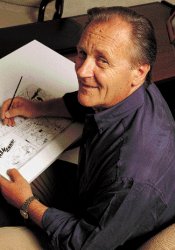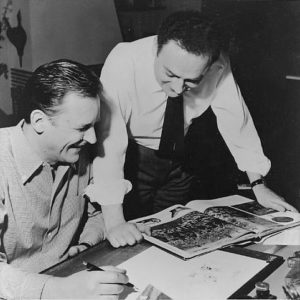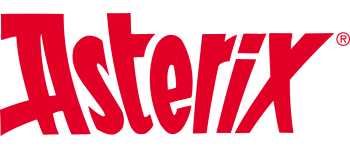
1927
Birth of Albert Uderzo in Fismes (in the Marne département in France).
1932
As early as his nursery-school days, young Albert shows great drawing ability.
He is completely self-taught, and his first vocation to be a clown develops into an irrepressible desire to draw, with an early attraction for Walt Disney heroes.
From the age of ten, Albert Uderzo begins to sketch characters with big noses …
1938
The family moves a second time, from Clichy-sous-Bois to the Rue de Montreuil, in the 11th district in Paris.
For a while Albert thinks about becoming an aircraft mechanic and passes the entrance exam to the French Engineering School before the Second World War breaks out.
1942
His brother Bruno then goes to Brittany and asks him to join him at Les Villages (in the Côtes-d’Armor département), near Saint-Brieuc.
Albert likes the area, but because of the war he has to return to Paris, where he helps his father, a machine operator working with wood.
With the Liberation of France, Albert tries his hand at cartoons, works for several magazines, and creates or draws new heroes such as Flamberge, Clopinard, Zartan, Zidore, Arys Buck, Prince Rollin and Belloy (the Invulnerable).
These characters begin a long series of pumped-up heroes with huge bulging muscles, the type of figure that Albert is particularly fond of.
1947
Then he does a spell in the army, in Tyrol.
When he returns, he becomes a reporter-illustrator for “France Dimanche” and works for two news agencies, small concerns modestly called World Press and International Press. There, among other great names in the cartoon world, he meets Jean-Michel Charlier and Victor Hubinon.

1951
Soon another person is to cross his path …
One fine morning in 1951, Albert Uderzo, who is working for World Press/International Press, is told that someone new, called ‘Gossini’ is coming to join them. When Albert hears this name, his Italian roots get all excited. But he learns that “No, his name is spelt G.o.s.c.i.n.n.y. He’s French and he’s moving here from the United States.”
The two hit it off immediately, and are to work on numerous joint projects. The partnership results in many heroes, including Oompah-Pah, whom many see as a precursor to Asterix.
1956
Uderzo and Goscinny then play an active part alongside Jean-Michel Charlier and Jean Hébrard to create the companies called Edipresse (news agency) and Edifrance (advertising agency), which at last give them the opportunity to express themselves independently. There follow several difficult years when the two try out various jobs, but this period is nonetheless extremely fertile in terms of projects and ideas.
At the time, to earn a living, Albert Uderzo goes so far as to produce nine plates in a week, a colossal amount of work. Sometimes, for lack of time, he skips the sketches and does his drawings directly in ink.
1959
Then an important project monopolises our two friends’ time: to create a magazine called Pilote, in conjunction with François Clauteaux, who will be the editor, Albert and René look for a typically French hero. The decision is made and they choose the Romance of Renart.
However, they are quickly told that the project is already under way, initiated by Jean Trubert. So their idea won’t work and they have to find another one. After exploring the historical ages of France, Albert and René agree on Gaul and the Gauls.
And so, on 29 October 1959, the FIRST issue of Pilote presents its captivated readers with the first plate of the Adventures of Asterix the Gaul, on page 20. The magazine is an immediate success: more than 300,000 copies sold!
Pilote (with its slogan, ‘wow, what a magazine!’) has its hour of glory. Many a young reader grows up with it.
Then it experiences a few ups and downs and our two friends hand over in 1960, only to come back in 1963. At the time René Goscinny works on numerous comic strips – Asterix, of course, as well as Iznogoud (Tabary), Little Nicholas (Sempé), Lucky Luke (Morris), Valentin (Tabary), The Dingodossiers (Gotlib), and more.
1968
The two authors continue some of the series for a while, either working together or on their own. However, from the “Asterix and the Chieftain’s Shield” album onwards, Albert Uderzo decides to devote himself exclusively to the little Gaulish hero and abandons his other characters.
1977
Asterix becomes a major French comic strip hero, with his popularity increasing album by album.
He brings great happiness to Albert and René, who by now have also founded a cartoon film studio, called Studio Idéfix. However, misfortune is just around the corner.
The awful news comes on 5 November 1977: René Goscinny dies during an exercise stress test for a medical check-up. He was 51. The shock is terrible. “Asterix in Belgium” is up to plate 37.
1979
From then on Albert Uderzo continues the adventures of the Gaulish hero alone.
He soon creates Les Éditions Albert René to publish new Asterix albums.
1980
Launch of The Great Divide, the 25th Asterix album, the first to be written and drawn by Albert Uderzo alone.
1981-2005
Launch of 8 new Asterix albums. Wiser for his friendship of 26 years’ standing with René Goscinny, Albert Uderzo writes and draws new albums proving a tremendous success with the ever-increasing number of Asterix readers. In November 2002 is launched a special album, a de luxe edition of “Asterix in Belgium”, as a tribute to René Goscinny (only available in French).
2009
In fifty years Asterix has become a publishing phenomenon. The figures speak for themselves: 34 adventures translated into 107 languages or dialects, 11 films, an Asterix leisure park, hundreds of by-products, and many other projects…
24th March 2020
Albert Uderzo died at home in Neuilly. His virtuoso drawing had the same panache, whether it was in realist work or the more humorous style, that he brought to his unique graphic creations. He will influence illustrators for many years to come and will continue to dazzle and entertain millions of readers.


